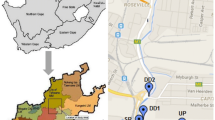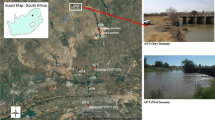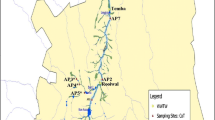Abstract
The diversity and abundance of coliform bacteria (taxonomically enterobacterias), an important quality water indicator, were determined for four representative caves in Slovak Karst: Domica Cave, Gombasecká Cave, Milada Cave and Krásnohorská Cave. Three hundred and fifty-two enterobacterial isolates were successfully identified by biochemical testing (commercial ENTEROtest 24) and selected isolates confirmed by molecular techniques (PCR, 16S rDNA sequence analysis). A total of 39 enterobacterial species were isolated from cave waters, with predominance of Escherichia coli, Serratia spp. and Enterobacter spp. PCR amplification of lacZ gene is not specific enough to provide a reliable detection of coliform bacteria isolated from the environment. Sequence analysis of 16S rDNA confirmed that all of the selected isolates belong to the family Enterobacteriaceae. In general, physical and chemical parameters of cave waters in Slovak Karst corresponded to national drinking water quality standards.



Similar content being viewed by others
References
Bej AK, Dicesare JL, Haff L, Atlas RM (1991) Detection of Escherichia coli and Shigella spp. in water by using the polymerase chain reaction and gene probes for uid. Appl Environ Microbiol 57:1013–1017
Campbell JW, Watson A, Watson C, Ball H, Pirkle R (2011) Escherichia coli, other coliform, and environmental chemoheterotrophic bacteria in isolated water pools from six caves in northern Alabama and northwestern Georgia. J Cave Karst Stud 73:75–82. doi:10.4311/jcks2009mb0131
Davalieva K, Kungulovski D, Atanasova-Pancevska N, Bojkovska R, Stafilov T, Efremov GD (2011) Microbiological and chemical characteristics of water and sediment from cave Vrelo, Republic of Macedonia. Contrib Maced Acad Sci Arts Sec Biol Med Sci 32:169–186
Elhottová D, Krištůfek V, Nováková A, Kováč Ľ, Mock A, Ľuptáčik P (2003) Domica a Ardovská Cave – study of the interacions between fauna and microflora (in Slovak). Aragonit 8:38–40
EN ISO 9308–1 (2003) Water quality. Detection and enumeration of Escherichia coli and coliform bacteria. Part 1: Membrane filtration method
Fricker EJ, Fricker CR (1994) Application of the polymerase chain reaction to the identification of Escherichia coli and coliforms in water. Lett Appl Microbiol 19:44–46
Gaál Ľ (2008) Geodynamics and development of caves in the Slovak Karst. Speleologia Slovaca 1 (in Slovak). Slovak Caves Administration, Liptovský Mikuláš
Gaálová B, Donauerová A, Seman M, Bujdáková H (2014) Identification and ß-lactam resistance in aquatic isolates of Enterobacter cloacae and their status in microbiota of Domica cave in Slovak Karst (Slovakia). Int J Speleol 43:69–77. doi:10.5038/1827-806X.43.1.7
Green W, Ellicott L, Crawford N (1990) Investigation of nonpoint source pollution associated with karst aquifer systems. Trans Ky Acad Sci 51:177–181
Haviarova D (2007) Karst waters research from the caves protection point of view in Slovakia (in Slovak). Podzemna Voda 13:153–159
Haviarová D, Seman M, Fľaková R, Ženišová Z (2011) Chemical composition and microbiological properties of water of selected cave systems in the Silická Plateau (Slovak Karst) (in Slovak). In: Grmela A (ed) Hydrogeochemistry 11. VŠB – Technical University of Ostrava, pp 39–42
ISO 6222 (1999) Water quality. Enumeration of culturable micro-organisms. Colony count by inoculation in a nutrient agar culture medium
Janda J (2001) Gramnegative bacterias in the karst waters. MSc thesis. Masaryk University in Brno
Jurado V, Laiz L, Rodriguez-Nava V, Boiron P, Hermosin B, Sanchez-Moral S, Saiz-Jimenez C (2010) Pathogenic and opportunistic microorganisms in caves. Int J Speleol 39:15–21
Kämpfer P, Nienhuser A, Packroff G, Wernicke F, Mehling A, Nixdorf K, Fiedler S, Kolauch C, Esser M (2008) Molecular identification of coliform bacteria isolated from drinking water reservoirs with traditional methods and the Colilert-18 system. Int J Hyg Environ Health 211:374–384. doi:10.1016/j.ijheh.2007.07.021
McFeters G, Bissonnette G, Jezeski J, Thomson C, Stuart D (1974) Comparative survival of indicator bacteria and enteric pathogens in well water. Appl Microbiol 27:823–829
Mello J, Elečko M, Pristaš J, Reichwalder P, Snopko L, Vass D, Vozárová A, Gaál Ľ, Hanzel V, Hók J, Kováč P, Slavkay M, Steiner A (1997) Explanatory notes to the geological map of the Slovak Karst 1:50 000 (in Slovak). State Geological Institute of Dionýz. Štúr, Bratislava
Mulec J, Krištůfek V, Chroňáková A (2012) Comparative microbial sampling from eutrophic caves in Slovenia and Slovakia using RIDA®COUNT test kits. Int J Spel 41:1–8. doi:10.5038/1827-806X.41.1.1
Novákova A (2006) Microscopic fungi in Dobšinské Ice Cave and in selected caves of the Slovak Karst National Park (in Czech). In: Bella P (ed) Research, utilization and protection of caves, 5th Proceedings. Slovak Caves Administration, Liptovský Mikuláš, pp 203–210
Pasquarell G, Boyer D (1995) Agricultural impacts on bacterial water quality in karst groundwater. J Environ Qual 24:959–969
Pasquarell G, Boyer D (1996) Herbicides in karst groundwater in southeast West Virginia. J Environ Qual 25:755–765
Seman M, Gaálová B (2009) Enterobacterial microbiota of cave waters of Silica Plateau (in Slovak). Acta Carsologica Slovaca 47:283–290
Tamura K, Dudley J, Nei M, Kumar S (2007) MEGA4: Molecular Evolutionary Genetics Analysis (MEGA) software version 4.0. Mol Biol Evol 24:1596–1599
Thompson JD, Gibson TJ, Plewniak F, Jeanmougin F, Higgins, DG (1997) The CLUSTAL_X windows interface: Flexible strategies for multiple sequence alignment aided by quality analysis tools. Nucleic Acids Res 25:4876–4882
Tomova I, Lazarkevich I, Tomova A, Kambourova M, Vasileva-Tonkova E (2013) Diversity and biosynthetic potential of culturable aerobic heterotrophic bacteria isolated from Magura Cave, Bulgaria. Int J Spel 42:65–76. doi:10.5038/1827-806X.42.1.8
Weisburg WG, Barns SM, Pelletier DA, Lane DJ (1991) 16S ribosomal DNA amplification for phylogenetic study. J Bacteriol 173:697–703
Acknowledgments
This research was supported by the grants of VEGA 2/0087/12 and VEGA 1/0899/12 from the Ministry of Education, Science, Research and Sport of the Slovak Republic. The authors thank the Slovak Caves Administration in Liptovský Mikuláš, Slovak Republic, for the opportunity of sampling the Domica Cave and BITCET (Biotechnological Center, Bratislava, Slovak Republic) for their sequencing of the bacterial 16S rRNA genes.
Author information
Authors and Affiliations
Corresponding author
Rights and permissions
About this article
Cite this article
Seman, M., Gaálová, B., Cíchová, M. et al. The occurrence of coliform bacteria in the cave waters of Slovak Karst, Slovakia. Folia Microbiol 60, 269–278 (2015). https://doi.org/10.1007/s12223-014-0362-y
Received:
Accepted:
Published:
Issue Date:
DOI: https://doi.org/10.1007/s12223-014-0362-y




